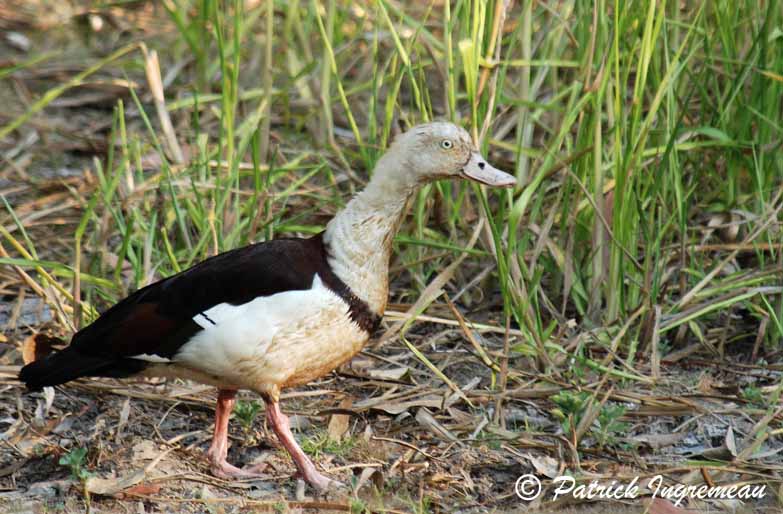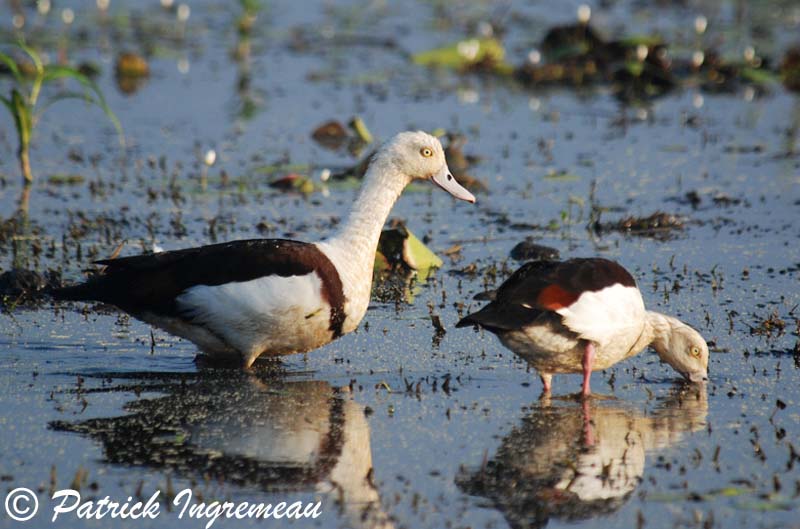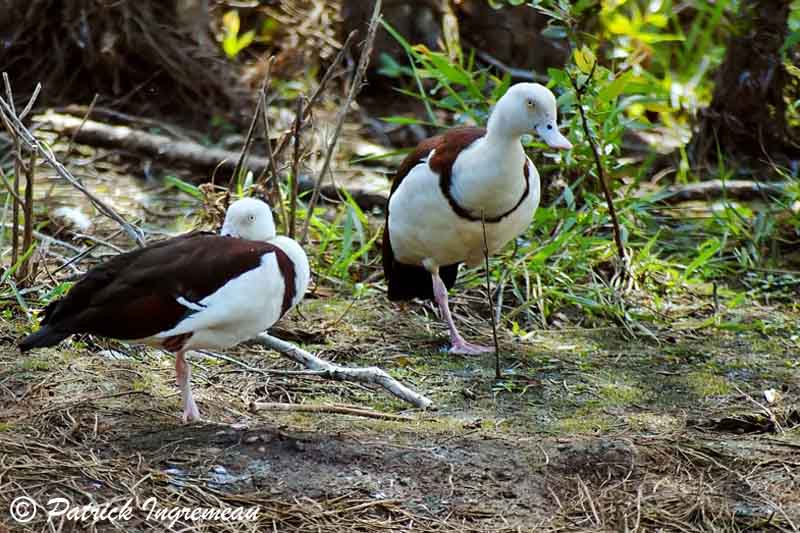
Radjah Shelduck
Tadorna radjah
Anseriforme Order – Anatidae Family
BIOMETRICS :
Length: 50-60 cm ; Weight: M : 930g – F : 840g
DESCRIPTION:
In this species, male and female are similar.
Radjah Shelduck adult is a large duck. It has black back, rump and tail. Mantel, scapulars and breast band are dark rusty.
Breast and belly are white. Upper and under wing coverts are mainly white. Flight feathers are blackish. Secondary feathers form bright green speculum, bordered with black in front, and with white stripe behind.
Head and neck are white.
Bill, legs and webbed feet are pink. Eyes are very pale, almost white.
Juvenile resembles adult, with white parts slightly washed brownish. On wings, it has more black on great coverts, and duller speculum.
Bill, legs and feet are whitish-pink. Eyes are dark brown.

VOICE: SOUNDS BY XENO-CANTO
Radjah Shelduck male utters raucous whistles, and female gives shrill, harsh rattles.
They are mainly noisy at rest and in flight.
HABITAT:
Radjah Shelduck lives in open fresh or brackish shallow water, in mangroves, coastal lagoons and mudflats, and occasionally in sheltered bays.
It can be seen further inland during the wet season.
RANGE:
Radjah Shelduck is mainly sedentary in coastal tropical northern Australia, from Central Queensland, through Northern Territory to Western Australia.
BEHAVIOUR:
Radjah Shelduck is usually seen in pairs or in small groups. Pairs form long-term pair-bonds. During wet season, male becomes very territorial, and it may attack its mate. They are strongly monogamous.

Radjah Shelduck feed by grazing in grasslands, or walking in mudflats, or by dabbling. But this species swims very well. They feed mainly at night.
Radjah Shelduck uses its bill to filter invertebrates and seeds from mud and water.
They rest during the day, perched in trees near water, often in mangroves.
Pairs often remain all year round in the same place, but they may perform some dispersion in dry season, searching for small ponds where they gather.
FLIGHT:
Radjah Shelduck has goose-like flight, with slow wing beats.
REPRODUCTION:
Radjah Shelduck pairs start to search a territory in January and February.
Nest-site is located near water, close to their food source. It is often situated in hollow in tree. Nest materials only include down feathers.
Female lays 6 to 12 creamy-white eggs in May-June. Incubation lasts about one month.
Chicks hatch covered with down, with black markings, white spots and dark chestnut crown, which extends to the eyes.
Chicks leave the nest very soon after hatching. They have to flutter and tumble to the ground, and even only covered in down, they run to the nearest water for safe. They are cared by both parents.

DIET:
Radjah Shelduck feeds mainly on molluscs, insects, bits of sedges and algae.
PROTECTION / THREATS / STATUS:
Radjah Shelduck is protected species in all parts of Australia.
If populations are not threatened, they are vulnerable to destruction by hunting. For that, it is now rare or absent in some areas of Australia.
Disturbances of these birds involve extremely harsh penalties.
Fr: Tadorne radjah
All : Radjahgans
Esp : Tarro Rajá
Ital : Casarca testabianca
Nd : Radjah-eend
Russe : Пеганка-раджа
Photos de Patrick Ingremeau
TAMANDUA
Texte de Nicole Bouglouan
Sources:
HANDBOOK OF THE BIRDS OF THE WORLD vol 1 by Josep del Hoyo-Andrew Elliot-Jordi Sargatal - Lynx Edicions - ISBN: 8487334105
Wikipedia (Wikipedia, The Free Encyclopedia)